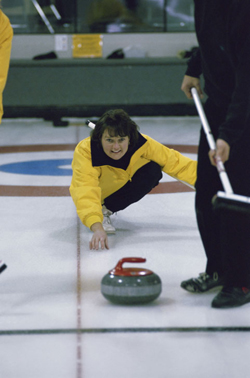Slip-Slidin’ Away

Enthusiasts for shuffleboard or the ancient sport of curling may have noticed a curious phenomenon: as a rotating disk skates across a surface, the spinning and sliding motions come to a halt simultaneously. In the 20 June issue of PRL a team of researchers explains this oddity and shows experimental data to support their theory. The theory says that friction couples sliding and spinning motions in a way that leads to the synchronized stopping. It also predicts that a spinning disk experiences less friction and slides farther than a disk without rotation, as the team found in the lab. The researchers think this lessening of friction may occur among the grains in granular flows, such as snow cascading down a mountainside.
The direction of the frictional force always opposes the direction of motion. A disk that’s both sliding and spinning has a complicated pattern of velocity across its surface: the spin causes one side to move faster than the center of the disk, while the opposite side moves slower or in the opposite direction. The velocity pattern determines the total friction on the disk, which is not simply the sum of friction calculated separately for disks that were sliding or spinning only.
This is an “almost trivial” result, says Dietrich Wolf of the University of Duisburg in Germany. “The surprising things are the consequences.” Rotation reduces linear friction, and lateral motion reduces rotational friction, so that a kind of negative feedback arises. For example, if a disk is sliding fast but rotating slowly, you might expect the spinning to stop first. But the lateral motion reduces the rotational friction, so that the spinning persists longer. Wolf and his colleagues prove that the coupling of the two forms of friction is such that all combinations of sliding and spinning converge to the same endpoint, with both motions ceasing at the same time.
To test their theory, the researchers spun a plastic disk across a flat surface many times and recorded the motion with a digital camera. This was a lot of fun, says Wolf, since in Germany theoretical physicists don’t normally do experiments. Even better, the results bore out their analysis. When the disk was spinning it traveled further than it did when sliding without rotation.
The researchers believe the results may apply to problems in granular flow, such as an avalanche, or grain flowing into a silo. When particles with flat facetted sides jostle and scrape past each other, the combination of linear and rotational motions may make friction less than might have been expected.
Although the new research has “interesting possibilities,” says Robert Behringer of Duke University in Durham, North Carolina, figuring out its real-life significance will be hard because “granular flows are horrendously complicated [and] poorly understood.” He thinks the phenomenon described by Wolf and his colleagues may be most important at the transition where dense powders begin to behave more like fluids.
One big unknown, says Leo Silbert of the University of Chicago, is whether particle surfaces remain in contact long enough for the coupling between sliding and spinning friction to influence the flow. Incorporating the new effect–“a nice, cute piece of work,” Silbert calls it–into a suitable computer simulation of granular flow would help answer such practical but exceedingly difficult questions.
–David Lindley
David Lindley is a freelance science writer in Alexandria, Virginia.


